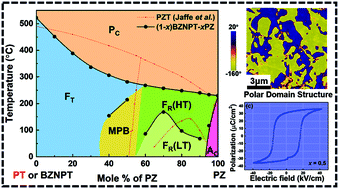Effects of antiferroelectric substitution on the structure and ferroelectric properties of a complex perovskite solid solution
Abstract
Ferro-/piezoelectric materials are crucial for a wide range of technologically important devices including electromechanical sensors and actuators and nonvolatile memory. In order to design new materials with high performance and high Curie temperature and to understand the underlying relationship between the structure and properties, a novel solid solution of a complex perovskite was synthesized in the form of ceramics using the solid-state reaction method. The effects of the substitution of antiferroelectric PbZrO3 (PZ) on the crystal structure, phase transitions, and dielectric and piezo-/ferroelectric properties of the Bi(Zn2/3Nb1/3)O3–PbTiO3 (BZN-PT) binary solid solution were studied. The phase transformation sequences of tetragonal ferroelectric phase → rhombohedral ferroelectric phase → orthorhombic antiferroelectric phase with a PZT-like morphotropic phase boundary (MPB) between the tetragonal and rhombohedral phases were indicated by X-ray diffraction and various electric measurements. A pseudobinary phase diagram delimiting the various phase regions was established by a combination of dielectric measurements, X-ray diffraction and selected area electron diffraction (SAED). Attractive electrical properties with d33 = 260 pC N−1, kp = 0.41, Pr = 31.2 μC cm−2, EC = 16 kV cm−1, TC = 281 °C and TMPB = 214 °C were obtained for the composition of x = 0.5, which is in the MPB region. A complex domain structure was found in this solid solution. Most importantly, the high piezoelectric properties obtained in the MPB composition was determined to arise from the significantly enhanced intrinsic contribution as evidenced by piezoresponse force microscopy (PFM). The enhanced electrical properties with a high TC and in particular a high TMPB in (1 − x)(0.2BZN–0.8PT)–xPZ arise from the combined effect of the MPB, the stereochemically active lone pair electrons on Bi3+ and the ferroelectrically active cations of Zn2+ and Nb5+, making it a novel piezoelectric material for electromechanical transducer applications. This work helps to further the understanding of the origin of the high piezoelectricity in bismuth-based solid solutions and opens up further investigation pathways into other bismuth-based solid solutions that could exhibit higher piezo-/ferroelectric performances.



 Please wait while we load your content...
Please wait while we load your content...